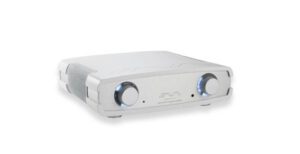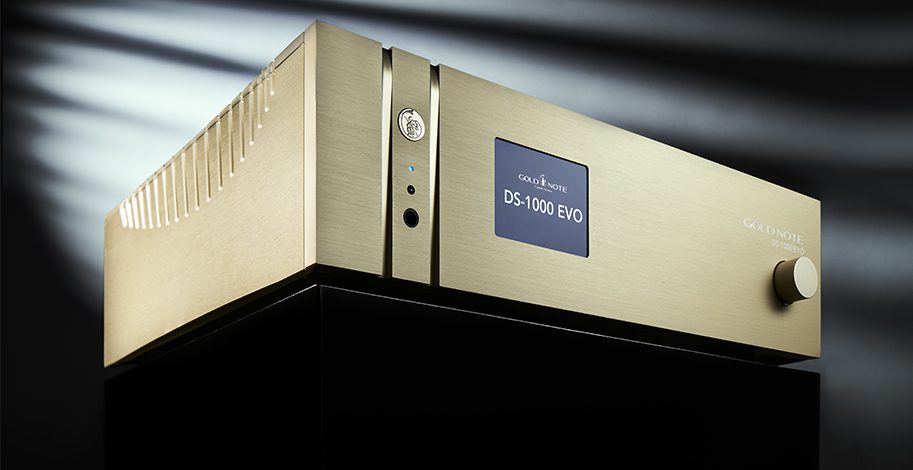
The Gold Note DS-1000 EVO has been one of the company’s mainstays in its higher-end electronics line. It’s a wireless streaming DAC, making it essentially your complete digital source component in a post-physical digital age. However, given it also has extensive digital connections that a disc-spinner might use, it’s also likely to be a digital hub for CD transports and other traditional digital audio devices. It has an optional XLR and RCA line inputs if you wanted to use the DS-1000 EVO as a line preamplifier (which is called the DS-1000 EVO LINE and is the model tested here), and a 1/4” headphone socket too.
In the past, Gold Note eschewed the notion of discussing its chipset, taking the very admirable line that suggests its a Gold Note product, rather than someone’s chipset in a Gold Note box. Unfortunately, this admirable line is often shouted down, so in the new DS-1000 EVO, Gold Note informs us that it features two dual-mono AKM AK4493 DAC chips. This boosts the resolution of the EVO over its predecessor; where the last topped out at 24/192, the EVO supports PCM files up to 32bit, 384kHz resolution and DSD from DSD64 up to DSD526 (and DSD512 via USB) native now.
Simplified, not simple
The Gold Note interface is one of elegant simplicity, but it is not a simple product. The front panel has a display screen controlled by a multifunction knob and aside from the remote eye, a little blue LED and that headphone socket, that’s it. The 3.5” TFT display is just large enough to read and not so large that you start to think it’s a touch-screen, although I still spent the first day or so uselessly mashing the panel. It’s a colour display but Gold Note’s use of colours is elegant and restrained. There’s that word ‘elegant’ again… get used to it, you are going to see it a lot over the next few pages.
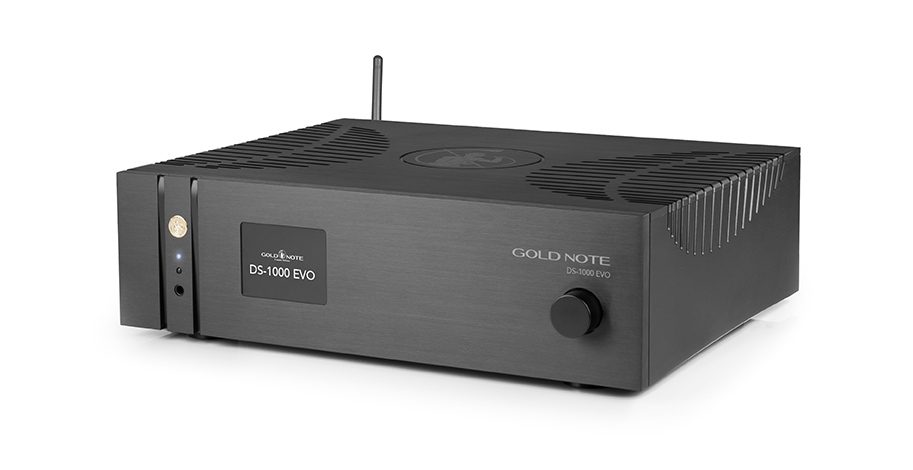
The DS-1000 EVO allows listeners to stream music wired though an Ethernet connection or wirelessly from a home network. It supports all the usual digital subjects (including Airplay), can use a USB drive as host, or take a USB feed from a computer (allowing native DSD streaming of DSD files) and comes with UPnP and DLNA network capabilities to control streaming, internet radio sources via vTuner, Tidal (via Tidal Connect), Spotify (via Spotify Connect), Qobuz, local media servers and so on, from the company’s own app or via the front panel. It is also Roon Ready. It can be bolstered up by the use of an optional external power supply upgrade, but this was not supplied for the test.
The Gold Note DS-1000 EVO also gives you the option of a ‘Tube’ output. This hooks directly to one of two output stages – the TUBE-1006 or 1012, which adds six (or 12 in the 1012) valves in a Class A output stage, which Gold Note says is for added warmth. This too was not supplied for test, but has been a known and popular upgrade for Gold Note’s higher-end products. In total, that would make the DS-1000 EVO take up three shelves, but if you use it as a line preamplifier too, that doesn’t sound too greedy. All three can be finished in Gold Note’s standard and elegant black, gold or silver finish.
The last link in the chain is the GN Control app, for iOS and Android products. This allows you to control all the DS-1000 EVOs functions both in the streaming section and some hands-on control of the DS-1000 EVO. Increasingly, the functionality of a product relies heavily on the quality of the app, and the Gold Note app is on the side of the angels.
The app isn’t as slick as some of the best in breed; I use an Innuos Statement Next Gen as my front end, and if I’m forced to choose between the two, I’ll go with Innuos. But, to its credit, it’s stable and fast, and isn’t overly fussy or busy. The app is backed up by a remote handset, which is itself useful for basic volume control.
In the LINE version, the DS-1000 EVO is equipped with a Class A line preamp stage to control the volume directly in the analogue domain, which can be bypassed when the DS-1000 EVO is set to DAC mode. The headphone amplifier meanwhile is more than just a feed from the line outputs, but a Gold Note developed circuit with high and low output settings to accommodate the widest set of headphone options.
Making your mind up!
I sometimes find that products like the Gold Note DS-1000 EVO seem to have trouble making up their minds. They are often a DAC that ‘does a bit of streaming’ or a streamer ‘that’s also got a DAC’. When you add a line preamp option, all bets are off. But the DS-1000 EVO is different. It has a strong sense of purpose to it; in the DS-1000 EVO it’s a streaming DAC and in the DS-1000 EVO LINE it’s a streaming DAC preamp. There isn’t a weak link in the chain, except maybe that its elegant front panel means a lack of hard buttons and control surfaces people have come to expect from their preamps.
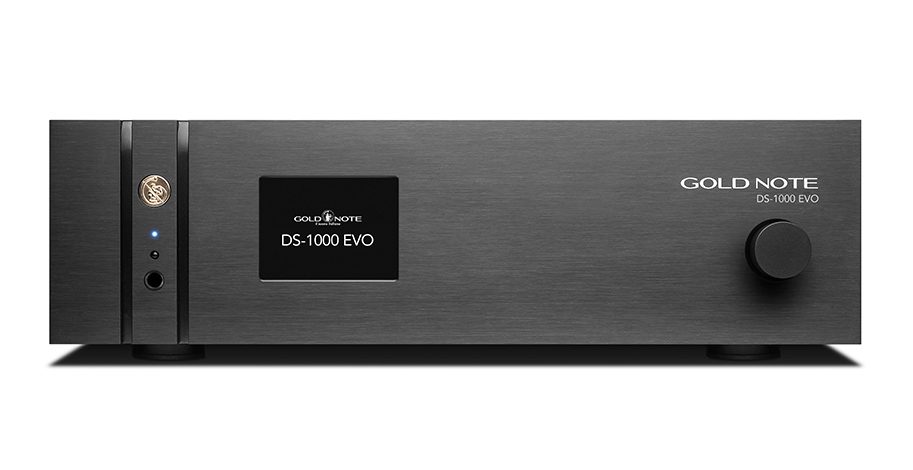
Gold Note makes a big play about the DS-1000 EVO and EVO LINE having what it calls an ‘Italian’ sound. I don’t like this concept, any more than I liked products ‘tuned’ for listeners in a specific country… but Gold Note has a point. Play any piece of music through the DS-1000 EVO and you are instantly reminded that it is made in Florence, thanks to a sumptuous passionate elegance (told you!) about that sound. It makes the kind of music that you feel duty bound to make sweeping hand gestures during the listening session. I could get into some low-rent stereotyping here, but this is a DAC with fire in its belly, passion in its heart and dresses in style!
The song, not the numbers
I can be inwardly curmudgeonly about piling on the ever higher-resolution formats. Sometimes they are more about the numbers than the song. And the recordings that suffer the most aren’t the high-resolution ones; they are the ones we listen to time and again, in and around CD quality. But here, the CD quality sings beautifully, and the higher-resolution sounds just add to the performance.
I can’t help but describe this (once again) as elegant. The sound has good imagery, excellent detail and dynamic shading and can scale well from a simple aria to a powerful orchestral tutti. The elegance is such that it’s difficult for the Gold Note DS-1000 EVO to make a bad noise.
If that makes you think the DS-1000 EVO softens its transients or somehow rolls off the sound; guess again. Playing some harsh 1980s post-punk (Joy Division’s Closer… I felt like I could do with cheering up!) and the hard, angular sound of late 1970s Manchester studios is portrayed properly. It’s just that despite it all, the sound is likeable rather than an ear-bleed.
Refined without over-refinement. Elegance without rococo frills and finery. Detail without sounding etched. Good soundstaging without sounding too dissolute. A dynamic range that can slam as much as it can burble along with the music. These are all elements that cannot be dismissed without sacrificing a lot of musical performance.
Even that English obsession of Pace Rhythm and Timing is well handled here. No, the rhythm kings and the timing obsessives will show how their foot tapping is 1% less direct, but the rarely see a bigger picture of wonderful coherence, across the board refinement… and my elegance meter is going off again. I played the Bach Trios by Yo Yo Ma, Chris Thile and Edgar Mayer. This is an extremely refined piece of music, but one with an edge caused by the presence of the mandolin. It is all about the microdynamic subtleties of the musicians, the portrayal of space and dimensionality around the music and both the sublime playing and the interpretation of Bach’s masterpieces. Get it wrong and it sounds fake and brittle, but here it places you in the recording suite, with a sense of overall musical beauty and (here it comes again) elegance that simply draws you deeper into the music. I would rather this than have this wonderful recording force-fed through an artificially beaty sound.
Even music that has a strong sense of beat fares well with the Gold Note DS-1000 EVO. Play something that you will nod along to – ‘Paranoid’ by Black Sabbath for example, or more contemporaneously ‘Dirty Rat’ by Sleaford Mods and Orbital or even some Techno – and you can’t help but nod, foot tap, do the whole ‘big fish, little fish, cardboard box’ thing. A lot of this comes down to the combination of excellent separation and great dynamic range, but the DS-1000 EVO is no rhythmic slouch.
I’ve saved the best until last, though. It’s the way the soundstage just envelops you that really sets the DS-1000 EVO apart. This shows the sound is leveraging at once the richer, warmer sound of Gold Note and a more direct, upbeat sound more common today. This is a delicate trade-off; too much warmth and the soundstage can appear soft and diffuse but too much top end energy and the staging becomes two dimensional. The balance is excellent here, and that comes across best when playing my benchmark Joyce DiDonato tracks from Stella Di Napoli {Erato]. Her voice sits perfectly between the loudspeakers, with rock solid stability, while the orchestra rise up to meet her voice, then falls away just leaving the French horn. It’s one of those recordings that can raise the hairs on the back of your neck, and it does wonders here. It might not look good, but goose-flesh is a very positive sign here.
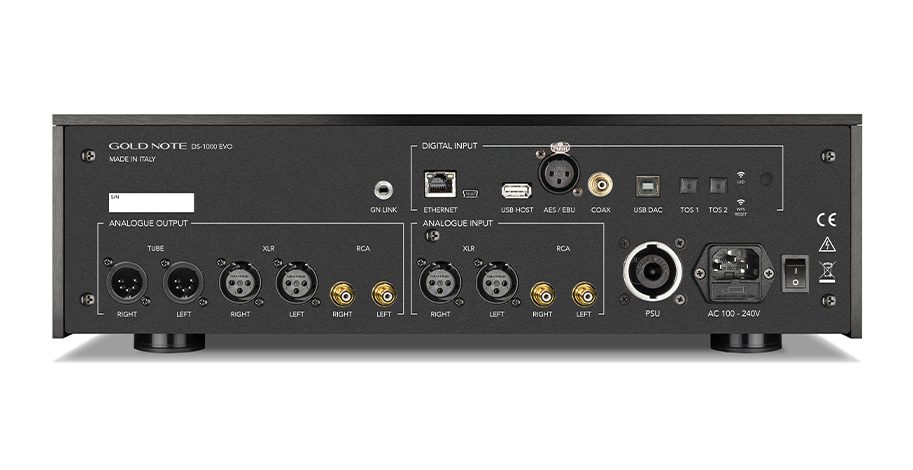
I’ve mentioned just how good the DS-1000 EVO is as a team, but what are the individual aspects of performance like? OK, it’s difficult to separate out the streamer because there is no digital output to by-pass the DAC. However, as a DAC, it’s an excellent performer; perhaps not as detailed as a similarly priced Chord Electronics model, but certainly sophisticated enough and more than dynamic enough to hold its own. Similarly the line preamplifier is a fine performer, but there are standalone models (including standalone models in Gold Note’s 1000 series range) that will add greater flexibility, more inputs and a touch more transparency across the mids and high frequencies. Finally, the streamer (as separated as it can get here) works well in its own right, but is outpaced by dedicated standalones like AURALiC.
This is getting away from the point of the DS-1000 EVO. It’s a proper digital audio hub (plus preamp if you go down the LINE route) that is a great sounding and convenient way to get that degree of musical elegance with minimal effort. No, it’s not the Lazy Man’s way to good sound, but it allows you to create a fine and sophisticated performance without the need for several boxes… unless you want the power supply and tube output stage. Even the headphone amplifier sounds – you guessed it – elegant!
Early sample
Ours was one of the first samples out of the Gold Note factory and bugs were expected, met and overcome. Typically in such cases, the end result is even better than the last models out of the designers test bench. But, even if not, the Gold Note DS-1000 EVO is a fine example of the Streamer/DAC and preamp breed and a worthy addition to the pantheon of high-performance digital audio. It’s the antithesis of that strident, aggressive digital sound, and yet it doesn’t deliver that more effortless sound through softening its presentation. In other words, it’s a gold star!
Technical specifications
- Type Solid-state stereo DAC with streaming and digital inputs
- D/A Converter 2x AKM AK4493 giving PCM up to 32-bit/384kHz and DSD512
- Supported audio formats AIFF (.aif, .aiff, .aifc), ALAC, WAV (.wav) packed/unpacked, FLAC, MP3, Apple Lossless, OGG, Monkey’s
- Supported Media Servers all UPnP, DLNA, Roon
- Supported streaming services Roon Ready, Airplay, MQA, Qobuz, Deezer, Spotify Connect, Tidal, Tidal Connect, vTuner
- Frequency response 20Hz to 20kHz (+/-0.1dB)
- Total Harmonic Distortion 0.001% max
- Signal to Noise ratio -125dB
- Dynamic Response 129dB
- Output Impedance 50 Ohm (RCA), 100 Ohm (XLR)
- Network Connectivity LAN/WLAN (WiFi) 802.11a/b/g/n/ac Dual Band (10/433Mbps), Bluetooth High Definition 5.0 (44/16)
- Dimensions (W×H×D) 43 × 13.5 × 37.5cm
- Weight 10 kg
- Price £5,559 (DS-1000 EVO); £7,269 (DS-1000 EVO LINE)
Manufacturer
Gold Note
Homepage – www.goldnote.it
Review Product – https://www.goldnote.it/electronics/ds-1000_evo/
UK distributor
Airt Audio
+44(0)754 879 6382
By Alan Sircom
More articles from this authorRead Next From Review
See all
PrimaLuna EVO 100 phono preamplifier
- Apr 22, 2024

Reiki Audio SuperSwitch Master Pro + Servant Pro
- Mar 27, 2024

Melco Audio N1-S38 music server
- Mar 27, 2024








